Collectively referred to as 'white-winged gulls', these two sporadic winter visitors can be present in good numbers in some years, although are generally scarce enough to make a day’s birding – especially the further south and east you are. While often straightforward to identify, both species can display considerable variation in plumage, size and structure, complicating matters. Hybrids and leucistic birds further muddy the waters. Josh Jones is on hand with all the advice and information you need to recognise these two perennially popular gulls.
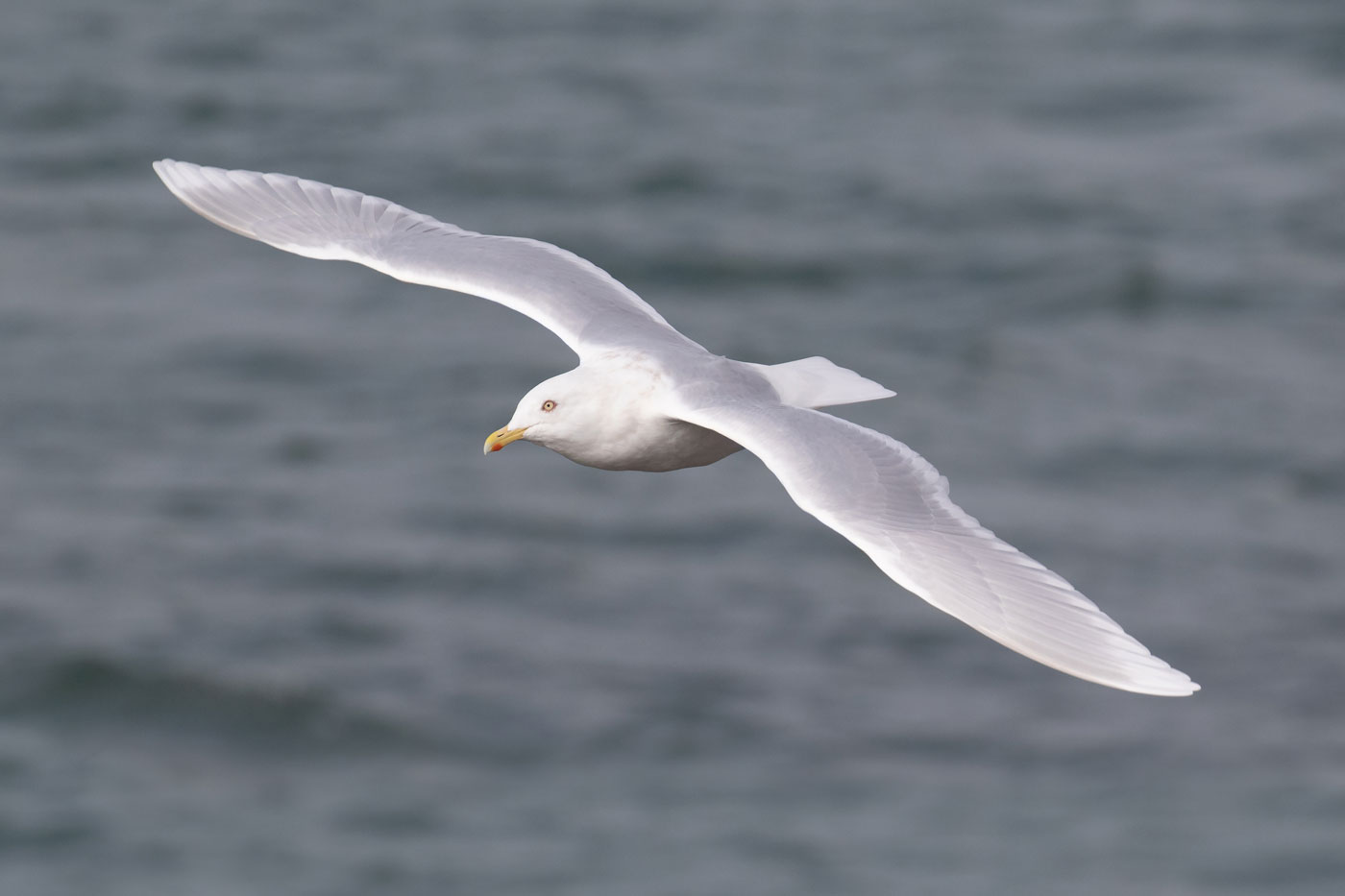
Iceland Gull (Cahersiveen, Co Kerry, 28 February 2020). Adult white-winged gulls are instantly recognisable for their pure white – rather than black – outer primary tips, as demonstrated by this pristine Iceland Gull. This individual, with its bright yellow bill and clean white head, lacking any blotching, is in full breeding condition, and will soon be departing its wintering location on the west coast of Ireland for breeding grounds in Greenland. It can be separated from Glaucous by its relatively short and slim bill, rounded head shape and large-looking eye, plus comparatively long and slender wings and relatively lightweight-looking body. Adults of either species are much scarcer than juveniles in Britain and Ireland, and any encounter – especially one as close as this – will always figure among the highlights of a winter birding day (Josh Jones / www.joshrjones.com).
Two Arctic-breeding gulls – Glaucous and Iceland Gulls – provide a welcome tonic in the often-murky world of large white-headed gull identification. They are highly distinctive in all plumages from the more familiar European Herring and 'black-backed' gulls, not least for their predominately white plumage – the most striking feature being the white rather than black primaries, which lends them the collective term of 'white-winged gulls'.
This generally makes them instantly recognisable and easy to pick out from the crowd, both at rest and in flight. This is most pronounced at an evening gull roost, where they will often appear to glow in the twilight.
While good views will generally allow the two species to be distinguished from each other with relative ease, this isn't always the case. There is considerable variation in size and structure, especially between males and females. Furthermore, the occasional complexity is thrown up by leucistic examples of the more familiar species, especially European Herring Gull, as well as some hybrid Glaucous × European Herring Gulls.
Both species are regular winter visitors to our shores, although their numbers vary significantly year on year and an influx of one species doesn't necessarily equate to plenty of the other. For example, in early 2012, a record-breaking influx involving several hundred Iceland Gulls reached Scotland and Ireland, but Glaucous Gull numbers remained at around average. One such factor affecting this is prevailing weather: strong north or north-westerly winds in late autumn and winter will often produce big arrivals.
Although they may be seen in the far north and north-west as early as September, November is usually when birds start appearing in earnest and begin to filter inland. Concentrations are typically at their highest from January to the beginning of March. An average year will usually see numbers into the low hundreds of both species.
The north and north-west extremities of Britain and Ireland tend to be the best places to see either species in any number – Shetland, the Outer Hebrides and western Ireland all routinely produce the biggest counts. However, with gulls such a ubiquitous part of life over great swathes of our isles, including urban areas, either can be encountered just about anywhere – although the general rule tends to be that the further south and east you go, the scarcer white-winged gulls become.
Note that this guide does not cover Kumlien's Gull, a taxon addressed by Peter Adriaens in Birdwatch 238: 41-47.
Glaucous Gull
This is a hefty, strong-looking gull, averaging larger than European Herring but slightly smaller than Great Black-backed. However, there is overlap with both species, with larger males being bigger than some Great Black-backs – an impression enhanced by the white plumage, which can make them appear even bulkier than they are.
It tends to readily associate with Great Black-backs, with the greatest numbers often found in remote, windswept parts of our isles – estuaries, headlands and beaches are favoured; a cetacean carcass will entice these Arctic bully-boys in for an easy meal.
The bill tends to be deep, long and strong looking, with a square-shaped head, relatively small eye and 'mean' facial expression. It is a solid, well-built species, often looking quite 'dumpy' due to its short primary projection.
Adults show pale grey upperparts, a shade paler than European Herring, with otherwise largely white plumage. In early winter the head and neck sport a variable amount of blotching, although most adults seen in Britain show largely clean white heads with minimal markings, especially by late winter. The legs are a rich pink colour, while in winter the bill is pinkish-yellow (becoming bright yellow by spring), showing a minimal red gonys.
Juveniles (not 'first-winter' due to a lack of post-juvenile moult) vary from almost entirely white (especially late in winter, when wear and bleaching take their toll) to a 'digestive biscuit' colour, with intricate, sometimes wavy darker markings on the coverts, tertials and scapulars. The primaries are white, although darker birds show internal 'arrowhead' markings along the feather shafts – these are often only appreciable at close range.
Crucially, the bill is always pink with a clearly demarcated dark tip, as if it has been dipped in ink; any candidate showing a different pattern is likely to either be an Iceland Gull, leucistic European Herring Gull or hybrid. The eye is always dark at this age, and the legs pink.
Second-winters are quite variable. Some are almost entirely white, while others are more 'milky tea' in colour and show finely patterned brownish markings to the coverts and tertials, as well as strong blotching on the head, neck and underparts. The iris is pale, while the faded pinkish bill retains the darker outer third, although the tip itself is usually pale.
Third-winters are similar but generally show more adult-like grey upperpart feathering, while fourth-winters look largely adult like.
Iceland Gull
Intermediate between Common and European Herring Gulls in size and structure, Iceland is a much daintier, more elegant and lightweight species than Glaucous, showing a longer primary projection, smaller, more rounded head, bigger eye and shorter, more petite bill, lending to an overall softer expression. However, note that males can be quite chunky, and may appear larger than some European Herring Gulls.
Adult winter Iceland tends to average a more heavily blotched head and neck to Glaucous, although it is again variable and many are quite clean headed, especially by February. The legs are quite short and a rich pink in colour, while the bill is greenish-yellow with a red spot on gonys.
As in Glaucous, juveniles range from white to a biscuit colour. The bill is variable, with some birds possessing a more Glaucous-like pattern, but many showing a less defined dark tip that 'bleeds' into the paler base. In some, the bill is largely dark.
Second-winters are variable, with some almost entirely white, while others are more heavily marked. Again, the iris is almost always pale. The bill is usually pink, but may also be a tepid greenish-grey. Third-winter birds show more adult-like features, such as grey upperpart feathering and bare-part coloration.
Iceland appears to more readily associate with smaller gulls and is more likely to be found in suburban settings than Glaucous, often coming to handouts in parks, while also being more associated with fishing ports and harbours than its bigger cousin, though habitat preferences are far from set in stone.
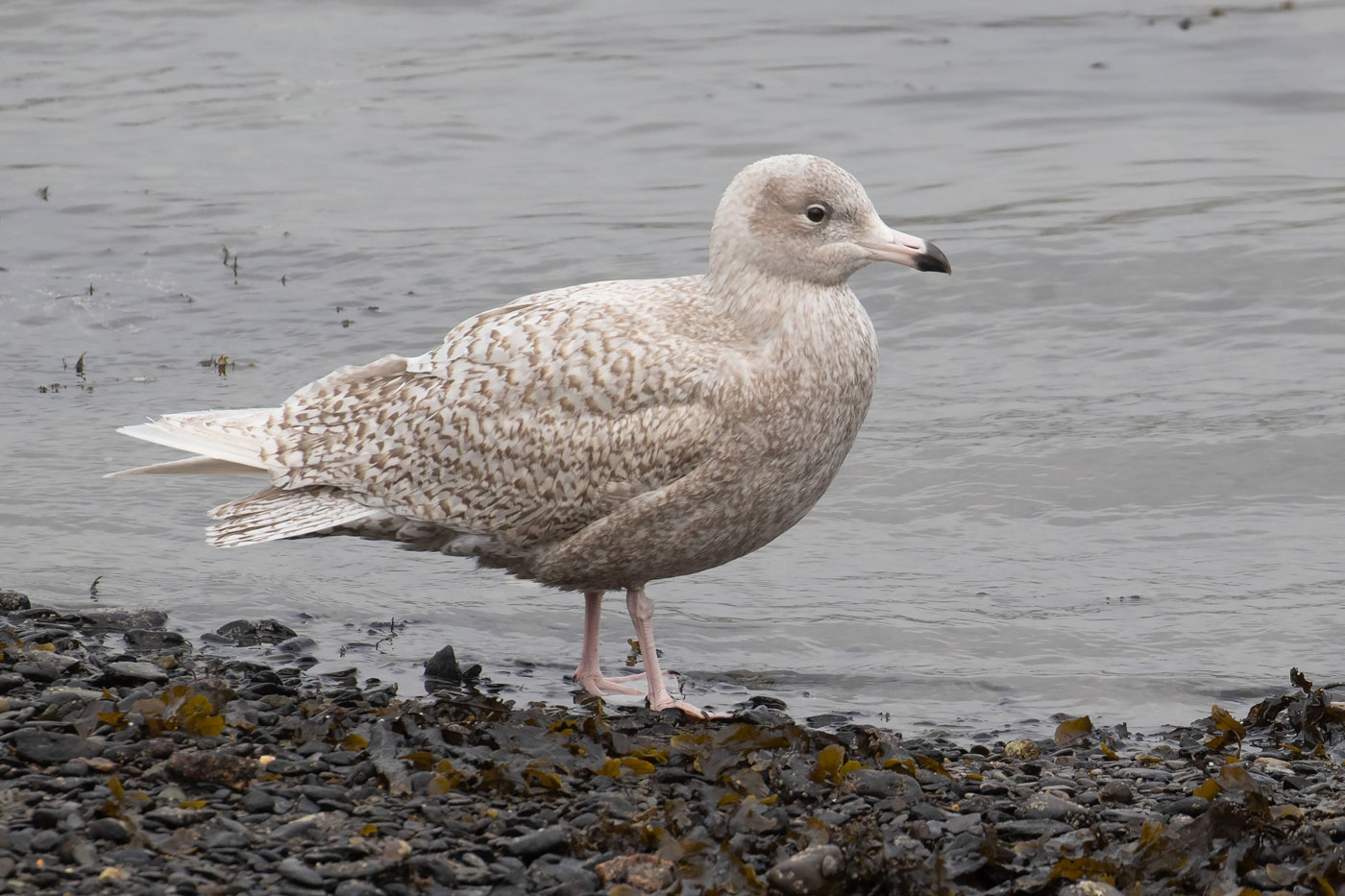
Juvenile Glaucous Gull (Waterville, Co Kerry, 28 February 2020). This is a middle-of-the-range bird, with a white basal colour to the plumage offset by pale biscuit-coloured blotching to the underparts and wavy markings on the mantle, coverts, tertials and tail. The primaries are largely white, apart from the faint internal 'arrowhead' markings. Some juveniles can be darker, particularly early in the season before wear and bleaching take their toll. Note the pale pink bill, the tip of which appears to have been neatly dipped in black ink. This individual has a softer expression than some, with a rounded head, and is likely a female. The overall bulkiness and relatively squat rear end, with 'short'-looking primaries are classic Glaucous (Josh Jones / www.joshrjones.com).

Juvenile Iceland Gull (Keflavík, Iceland, 20 February 2018). Some juvenile Iceland Gulls show pale pink bills with relatively neat black tips, recalling Glaucous. However, note the overall structure of the bird: a small, rounded head and dainty, short bill giving a 'cute' expression, a more attenuated rear end with significantly longer primary projection than the preceding Glaucous, and the more lightweight-looking body. The plumage is otherwise quite similar, with the upperparts being the palest part of the bird. Plumage can be very alike in the two species at all ages, and overall gait and structure are sometimes the best way to tell them apart (Josh Jones / www.joshrjones.com).
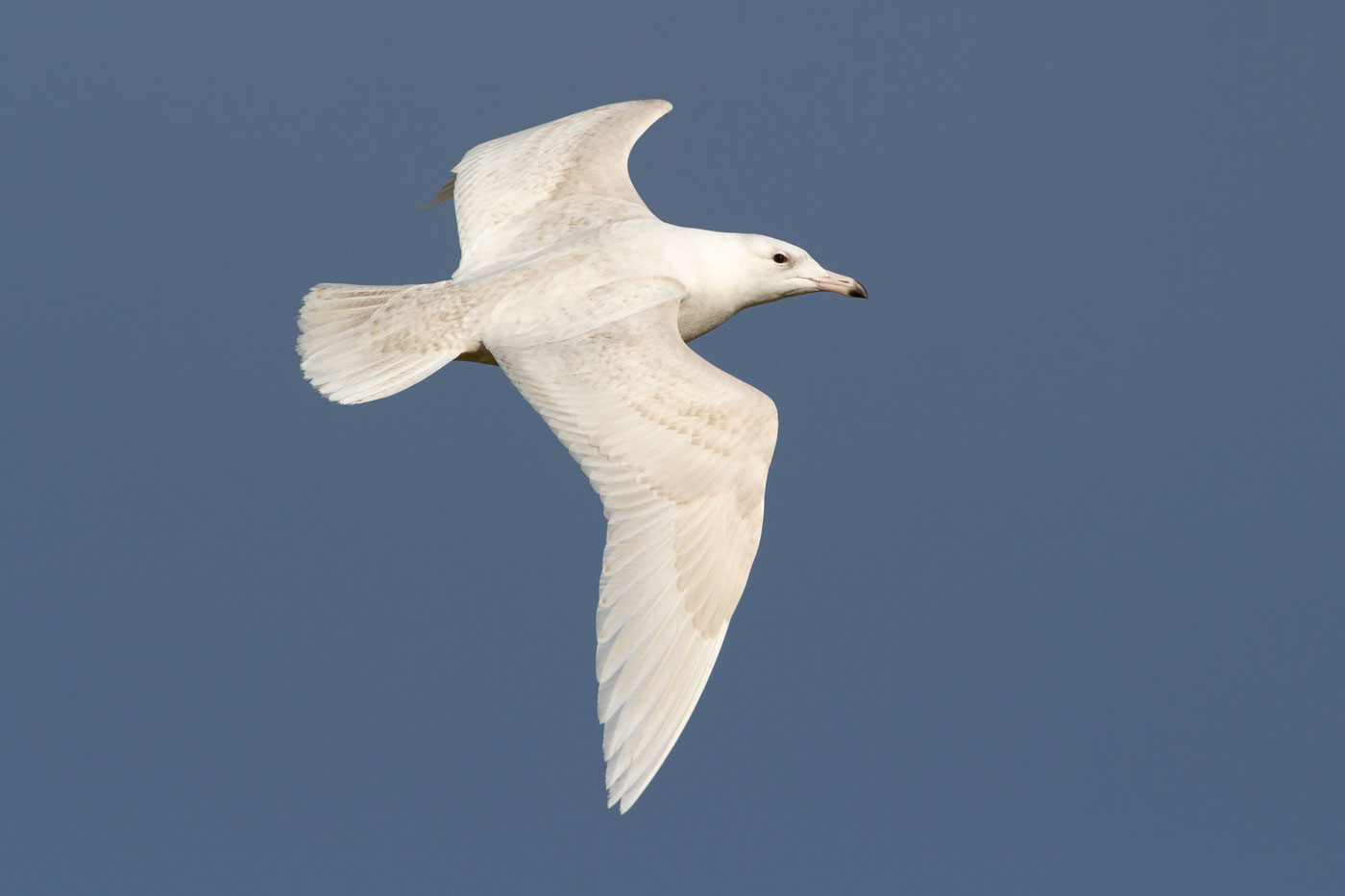
Juvenile Glaucous Gull (The Mullet, Co Mayo, 20 February 2014). Some juvenile Glaucous are almost white, showing little more than residual tea-coloured markings on the upperparts – especially by late winter, when wear and bleaching take effect. Separating such birds from second-winters isn't always easy, but note the dark eye, pale pink bill with solid black tip and the pointed tips to the primaries – in older birds, they are more rounded. Overall, this looks a well-built bird – the strong, deep bill, square-shaped head and thickset neck are all good indicators that it is a Glaucous (Josh Jones / www.joshrjones.com).

Juvenile Iceland Gull (Dingle, Co Kerry, 15 March 2020). This bird is superficially very similar to the preceding Glaucous, being very white and showing equally minimal darker residual markings. However, the bill is slender in structure and, while showing a pale base, diffusely darkens to the blackish tip – a pattern never seen in pure Glaucous, but common in Iceland. Additional pointers to Iceland include the smaller, more rounded head, less thickset neck and proportionately longer and slimmer wings (Josh Jones / www.joshrjones.com).
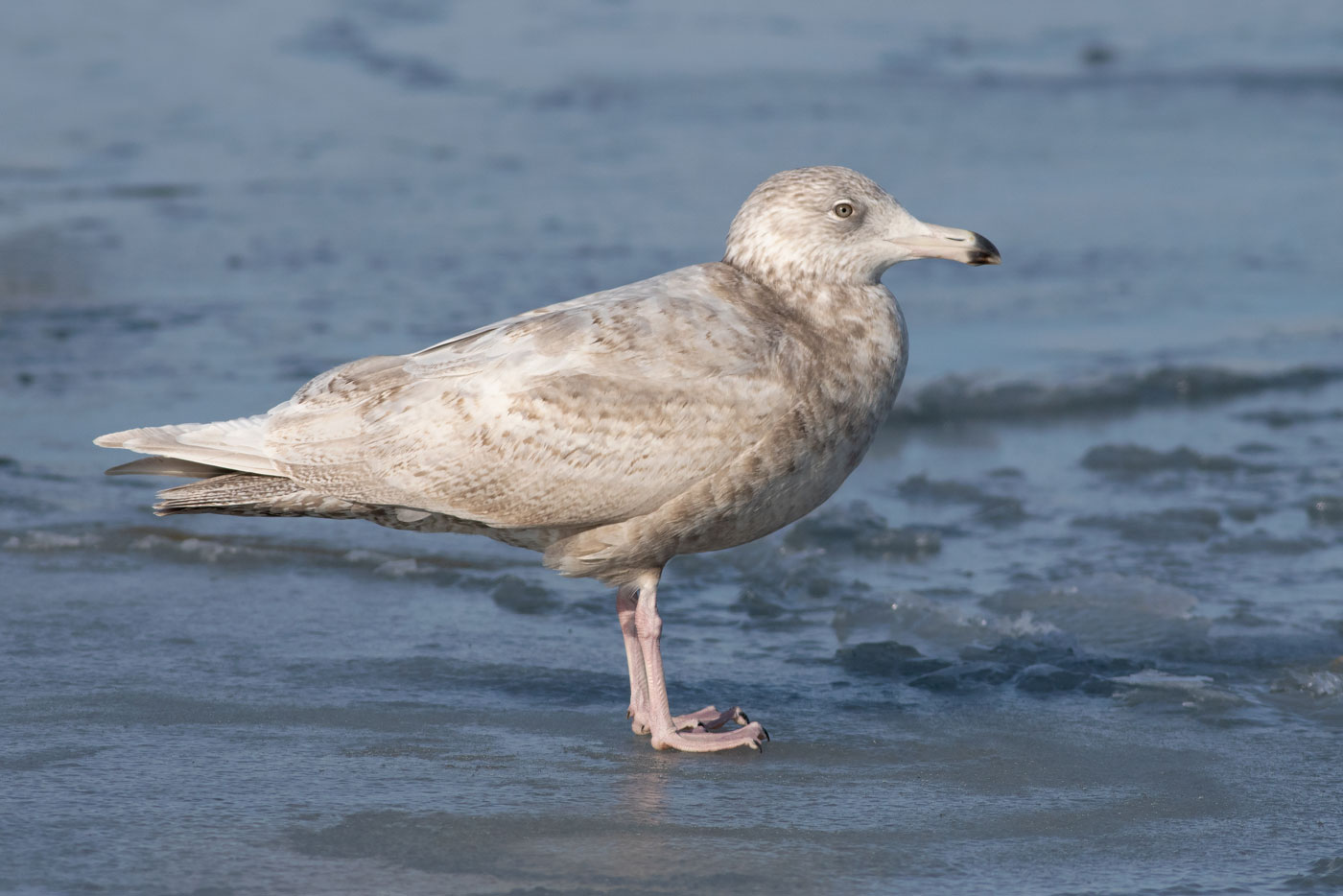
Second-winter Glaucous Gull (Hokkaido, Japan, 31 December 2015). The pale iris and pinkish tip to the bill, diffuse plumage with 'chainmail' patterning to the coverts, as well as more rounded primary tips, indicate that this bird is a second-winter. In terms of plumage, this is towards the darker end of the spectrum for this age, with extensively blotched head, neck and underparts and plenty of biscuit-coloured patterning to the upperparts. The strong-looking bill, big head, short primary projection and overall robustness all point to Glaucous (Josh Jones / www.joshrjones.com).

Second-winter Iceland Gull (Achill Island, Co Mayo, 19 February 2014). The iris on this advanced bird is already adult-like, although some second-winters can show a darker eye closer to (but never matching) that seen in juveniles. Overall, the plumage is white, with faint markings to the upperparts and upperwing, as well as some diffuse blotching below. Bill colour at this age is variable from pinkish-grey to greenish-grey with a dark tip that ranges in its extent. Note how attenuated the bird looks compared to the preceding Glaucous due to the long primary projection, while the small, rounded head and short bill are also apparent (Josh Jones / www.joshrjones.com).

Second-winter Glaucous Gull (The Mullet, Co Mayo, 20 February 2014). This stunning bird is close to being as pale as second-winter Glaucous gets, being almost entirely white save for some minimal diffuse blotching on the belly. The iris is already very pale and the bill is largely a washed-out pink, with a darker subterminal band. Seen among European Herring or black-backed gulls, this individual would really stand out! (Josh Jones / www.joshrjones.com).

Second-winter Iceland Gull (Keflavík, Iceland, 21 February 2018). Some second-winter Icelands can be almost entirely white, as with the preceding Glaucous. However, even the more extensively patterned birds – such as this one – nonetheless looking strikingly white when seen in flight. As well as the more rounded wing-tips, key indicators that this is a second-winter rather than juvenile include the pale iris, tepid greenish-grey bill colour, as well as the more intricate markings to the upperwing coverts and tail. Again, note how short the bill is and how small-headed the bird looks (Josh Jones / www.joshrjones.com).

Sub-adult Glaucous Gull (Keflavík, Iceland, 22 February 2018). Ageing immature gulls isn't always easy, as some individuals mature more quickly than others. This Glaucous looks largely adult-like, but some retained immature feathering can be seen in the tail and rump, while the bill is more pink than yellow and retains a dark marking at the gonys. It is most likely an advanced third-winter, but it's difficult to be sure. Others of this age would show more extensive signs of immaturity, such as a younger-looking bill or more immature feathering in the greater coverts and tertials (Josh Jones / www.joshrjones.com).

Third-winter Iceland Gull (Essex, 13 February 2016). In contrast to the preceding Glaucous, this third-winter Iceland (known to be this age as it was a returning bird) retains an extensive suite of immature feathering and could easily be passed off as a second-winter. Aside the adult-like grey feathering in the mantle and lesser coverts, there are very few clues to suggest its true age and it demonstrates how some immatures are best left unaged. A more recognisable third-winter would show extensively adult-like upperparts and less black in the bill (Josh Jones / www.joshrjones.com).

Adult Glaucous Gull (Hokkaido, Japan, 29 December 2015). This is a fairly short-billed and small Glaucous, and thus probably a female. However, note how the deep-based the bill is, as well as how the basal two-thirds is extensively washed with pale pink (this is greenish-yellow in Iceland), giving a fleshy appearance. This, combined with the relatively short primary projection, big-headed look and overall robustness of the body, indicate that it is a Glaucous (Josh Jones / www.joshrjones.com).

Adult Iceland Gull (Iceland, 6 January 2017). In contrast to Glaucous, adult winter Iceland shows a greenish (rather than pinkish) wash to the basal two-thirds of the bill. Note also the long primary projection and consequent attenuated appearance, as well as small, rounded head and short, narrow bill. The legs are a rich raspberry-pink. This is about as heavily blotched as adult Iceland Gull gets; plenty show much reduced head and neck markings in the winter months (Alex Máni).
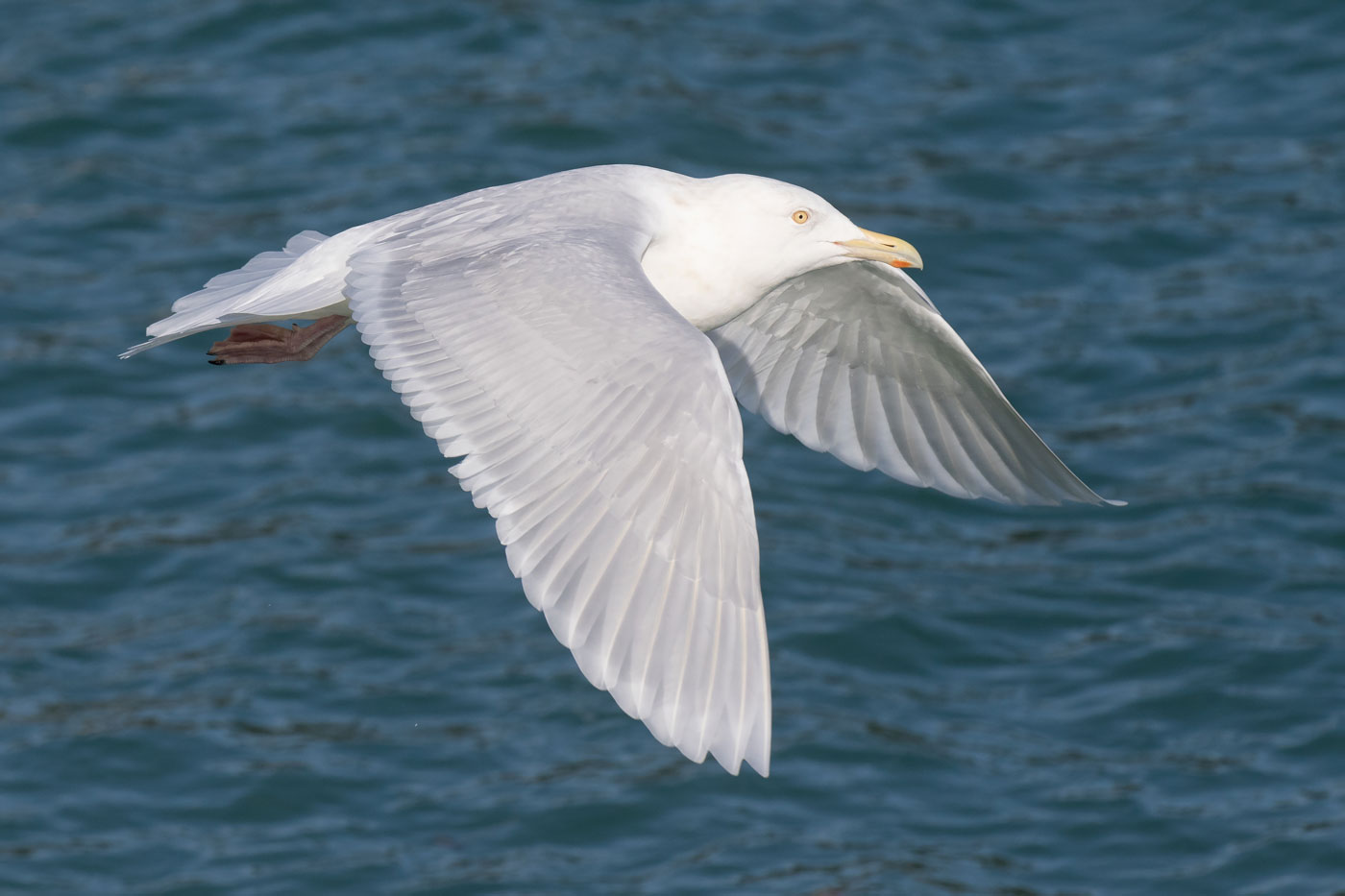
Adult Glaucous Gull (Crookhaven, Co Cork, 27 February 2020). In strong sunshine, even adult white-winged gulls can look almost entirely white, with the pale grey upperparts registering as little more than a ghosting on the white basal colour. Separating the two species isn't always easy in flight, but note here the square-shaped head, long and deep-based bill and rather thickset neck, which gives a hefty impression and diagnoses it as a Glaucous. Most adults of this species seen in Britain or Ireland tend to look clean headed like this bird, even in midwinter (Josh Jones / www.joshrjones.com).
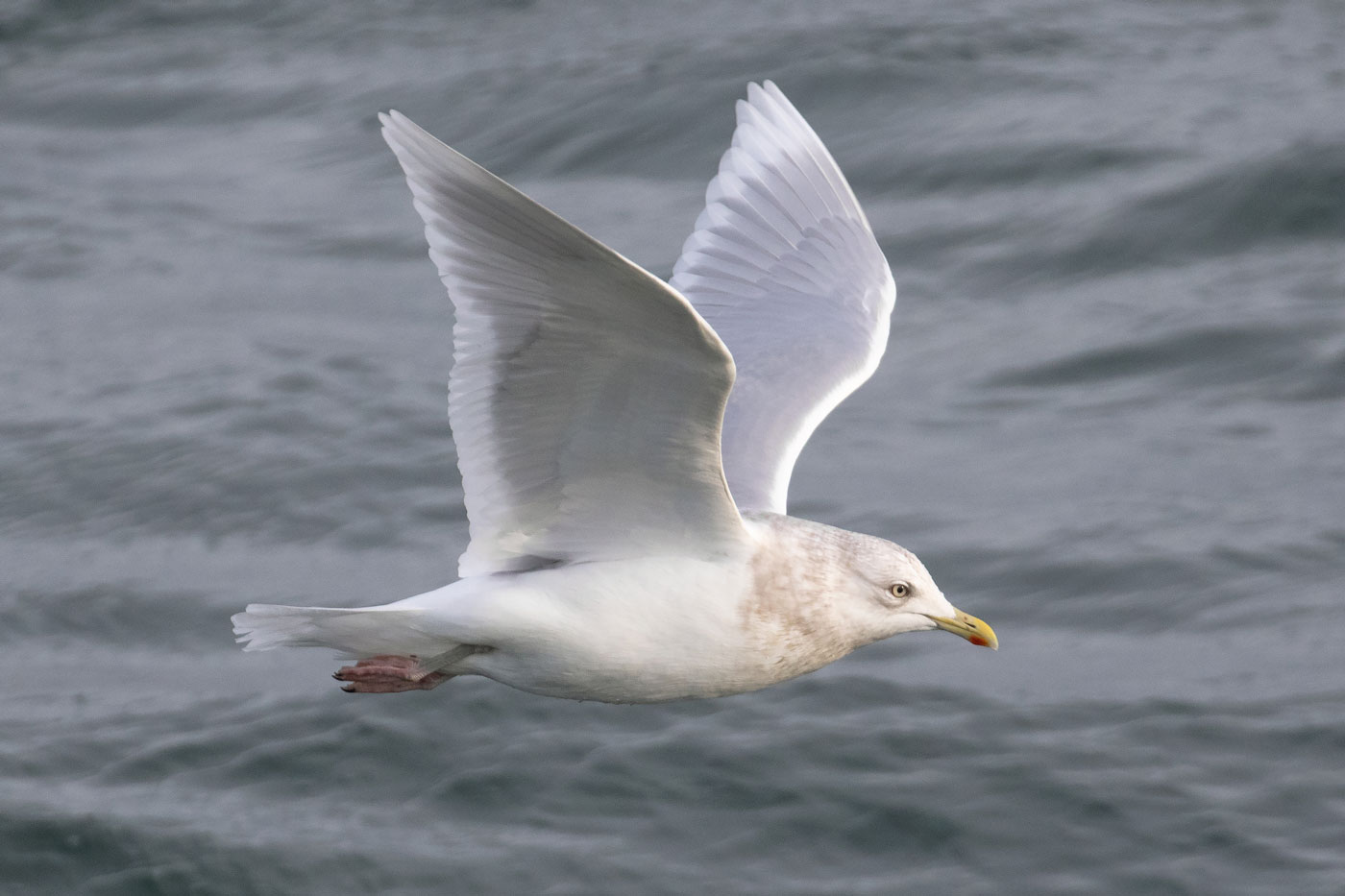
Adult Iceland Gull (Keflavík, Iceland, 20 February 2018). This bird is identifiable as an Iceland Gull due to its short, dainty-looking bill and relatively small head. It shows extensive blotching to the head and especially neck, although isn't as densely marked as that two images previous (Josh Jones / www.joshrjones.com).

Third-winter Great Black-backed Gull (Essex, 7 February 2016). An assortment of leucistic and hybrid birds can pose as imposters for genuine white-winged gulls, and this leucistic Great Black-backed is no exception. The robust structure, largely white plumage, plus deep-based, pinkish bill with black tip and pale iris all strongly recall a second-winter Glaucous Gull. However, note that the most pigmented parts of this gull are the mantle, covert and tertial feathers, and the last even shows the ghosting of white-tipped feathers seen in a 'normal' bird, and the bill and head structure are typical of GBBG (Josh Jones / www.joshrjones.com).

Second-winter European Herring Gull (Thamesmead, London, 18 January 2020). This very white bird could easily invite confusion with Glaucous or, especially, Iceland Gulls, particularly if not seen well. However, tea-coloured pigmentation is most prevalent in the outer primaries, secondaries and tail band, which are typically the darkest parts of a 'normal' second-winter European Herring Gull. This is at odds with either immature white-winged gull, where the outer primaries are the always whitest part of the wing. Putting aside the exceptional plumage, the head and bill structure are spot on for European Herring (Richard Bonser).

European Herring Gull (Crayford, London, 23 September 2018). This is possibly the same bird pictured in the previous image, albeit a year younger. The darkest parts of this bird are the outer primaries, secondaries and upperwing coverts, which all portray a 'ghosting' of the typical pattern of this species. The dark iris indicates its age as a first-winter. The dark bill immediately rules out Glaucous. Darker outer primaries aren't compatible with either white-winged gull and this bird should be quickly discernible as a leucistic European Herring, even if its paleness might initially give the observer a fright! (Jamie Partridge).

Presumed Glaucous × European Herring Gull (Iceland, 22 February 2018). This juvenile is overall very Glaucous-like, with a neatly demarcated black tip to the pink bill and overall biscuit colour. However, the plumage is rather coarse for a typical juvenile Glaucous, and the primaries show rather a lot of pigmentation – they appear as dark, if not darker than the body. Structurally, it is also quite lightweight. The lines are somewhat blurry as to where exactly pure, darker-end Glaucous become hybrids in terms of appearance, especially in Iceland where hybridisation is rife, but this bird seems to show enough to suggest it has European Herring genes in its ancestry. Many hybrids are more obvious, showing features such as more solidly pigmented primaries or a less clear-cut bill pattern.
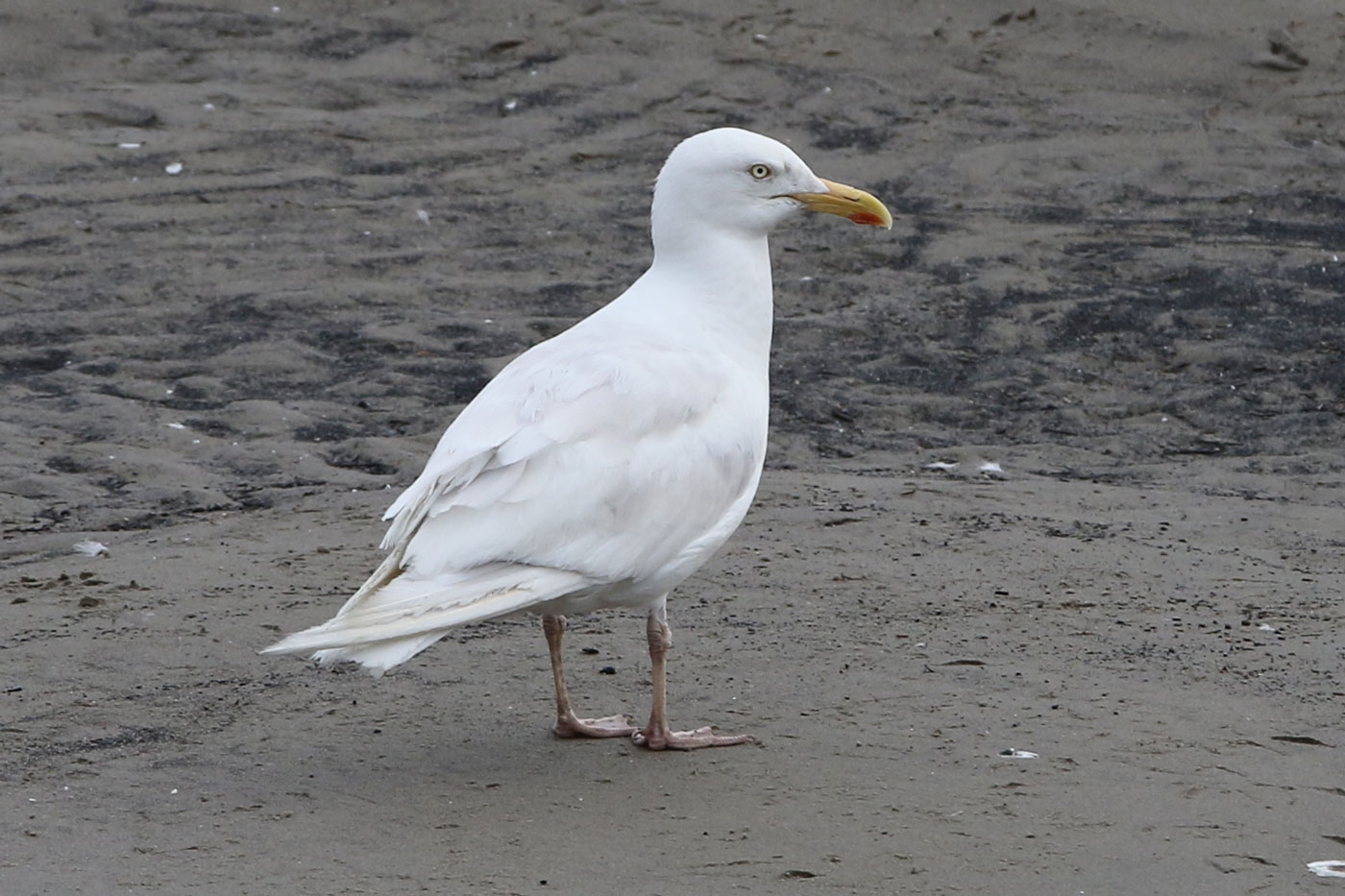
European Herring Gull (Greenwich, London, 2 July 2016). This remarkably white bird could easily fool the observer into thinking it was either Glaucous or Iceland, but note the location and date – an adult white-winged gull in London in July would be unheard of. Note how the upperparts are largely white rather than pale grey, and the primaries show a faint hint of tea colouring. This is in fact a leucistic European Herring Gull, an identification which is further backed up by the overall structure and proportions of the bird, which fit neither Glaucous nor Iceland (Richard Bonser).
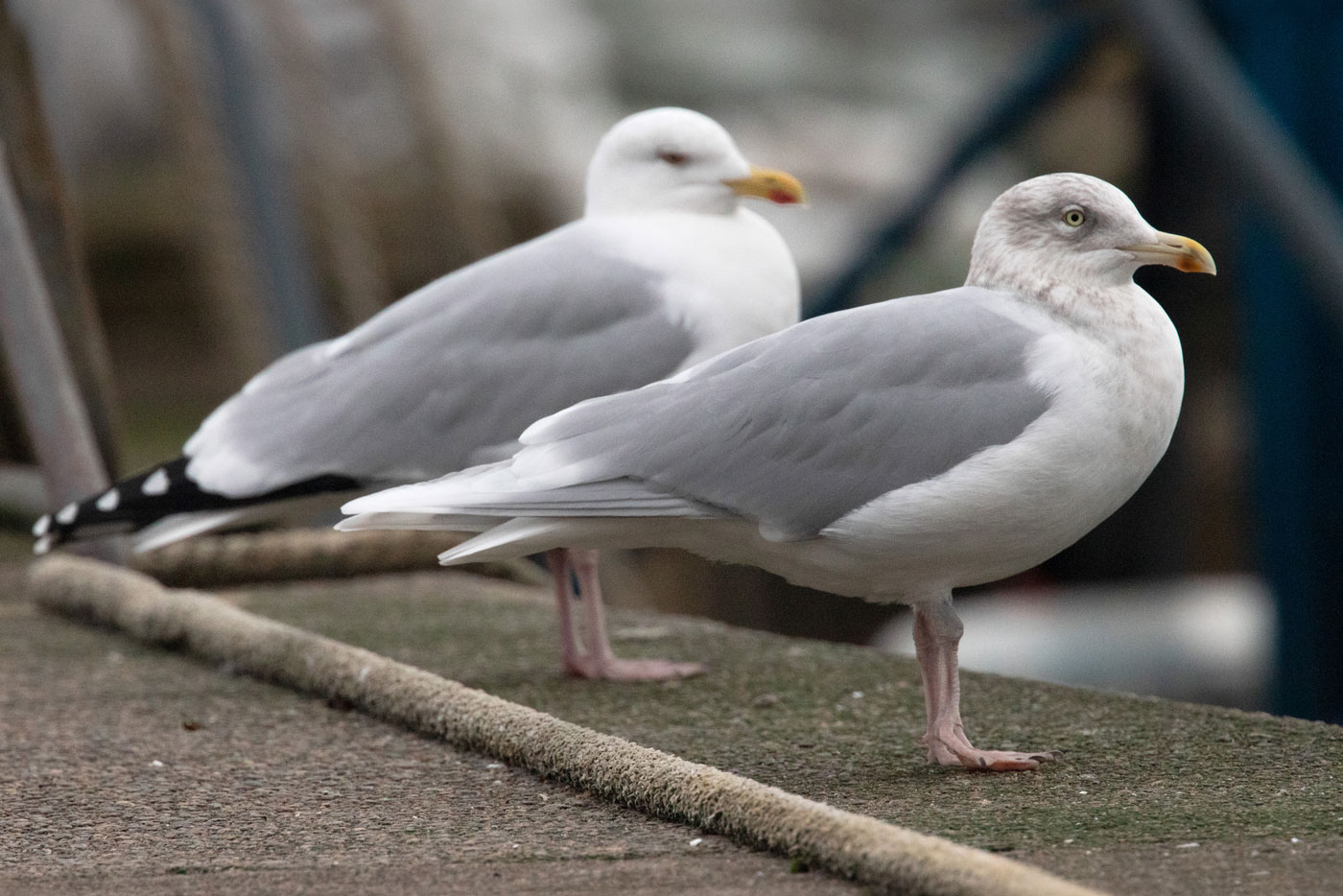
Adult Glaucous × European Herring Gull (Mallaig, Highland, 19 November 2017). This well-known bird returned every winter from first-winter to adult plumage (as shown here). With its white primaries, it immediately recalls both Glaucous and Iceland Gulls, but is somewhat intermediate in its overall size, structure and appearance – that's because this confusing bird is actually a hybrid. A few clues hint at this, including the European Herring-like head and bill, as well as upperpart coloration, which is virtually indistinguishable from the European Herring behind (Peter Stronach).
- This article was originally published in the December 2020 issue of Birdwatch magazine.


